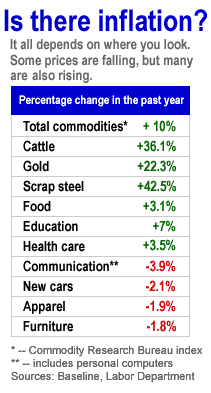NEW YORK (CNN/Money) - Since they did such a good job of finding Saddam Hussein, maybe the U.S. 4th Infantry Division can be hired to hunt down all the inflation that's supposed to be threatening the U.S. economy.
Everywhere you turn, there are red-light indicators of inflation: the dollar's value is plunging, gold prices are through the roof and commodity prices are marching upwards, including Alan Greenspan's pet indicator, scrap steel.

But Tuesday's report by the Labor Department on consumer price inflation in November showed no sign of inflation. In fact, the department's core consumer price index (CPI) fell for the the first time in 21 years. In the past 12 months, core CPI has risen at the slowest pace in 40 years.
Bond market vigilantes have lambasted the Federal Reserve in recent weeks for its apparent ignorance of gathering storm clouds of inflation, and the implicit threat of higher interest rates, a harsh investment climate, and a slowing economy.
So Fed policy makers surely took comfort in the CPI report, which seemed to justify their decision last week to keep short-term interest rates at the lowest level since the 1960s.
"That low inflation rate leaves the Fed plenty of latitude to remain on hold, and reinforces our expectation that [a rate increase] is unlikely before the third quarter of 2004," said UBS Warburg chief economist Maury Harris.
"Armed with the weaker U.S. dollar, commodity prices heading north, and a strengthening economy, rising inflation pressure is still likely to emerge as a concern for the Fed," said Sherry Cooper, chief economist at BMO Nesbitt Burns. "But not yet. Not yet."
Profit squeeze? Not necessarily
"The fact that we can lower living costs at a time when output and income are recovering should be considered fantastic news," said Citigroup senior economist Steven Wieting.
Low prices, after all, are good things for consumers, keeping goods and services affordable and raising standards of living.
| Related stories
|

|
|
|
|
But low consumer prices could be a big headache for some U.S. manufacturers, who are feeling the pain of higher prices in the production pipeline.
Last week, the Labor Department said prices for core crude goods -- such as cotton -- had risen 17.1 percent in the past year, while prices for finished goods -- cotton shirts -- had risen just 0.5 percent. Some economists fear that this pricing imbalance will crimp corporate profits.
"When combined with the run-up in employee health-care costs," said Wachovia economist Mark Vitner, "the inability to raise selling prices is the single most important reason that job growth has been lagging so much during this recovery."
Others, however, noted that high productivity has enabled companies to milk more output out of their existing labor force, eliminating the need to hire more workers and easing the sting of higher health-care costs. What's more, commodity prices make up just a small part of the total economy, which is overwhelmingly service-producing rather than goods-producing.
These economists noted that U.S. companies had little problem turning a profit in the 1990s, when inflation was falling, and struggled to turn a profit in the 1970s, when inflation was rising.
"If firms need pricing power, they should be clamoring for the highest possible rates of inflation," said Joshua Feinman, chief economist at Deutsche Bank Asset Management. "Firms don't have pricing power, but they can still make money, and a lot of it."
Stealth inflation
Other economists, however, warn that troublesome inflation is inevitable when the economy is growing at its full potential -- as most observers think it will next year -- and they suggest the Labor Department's CPI number may be too flawed to register it.
A favorite target for derision in the CPI is a thing called "owners' equivalent rent," which is a made-up number that tries to guess what homeowners would spend if they were renting their home instead of owning it. It's the biggest part of the index, making up more than 20 percent of total CPI.
The only problem is that rents have plunged in recent years as people have clamored to buy homes, possibly making the equivalent rent measure inaccurate. There are other potential problems with the CPI, but suffice it to say that some analysts think inflation won't show up in the CPI right away.
Instead, the first canary to sniff inflation in this coal mine could be interest rates. When the Fed finally sees the whites of inflation's eyes, these analysts fear, it'll have to hurry up and take away the economy's punch bowl.
"What'll happen is you'll see bond yields spiking higher, the dollar spiking lower and the Fed then having to raise rates," said Paul Kasriel, director of economic research at Northern Trust in Chicago. "At that time, housing will probably start to weaken, stocks won't do well, and our standard of living will go down."

|

